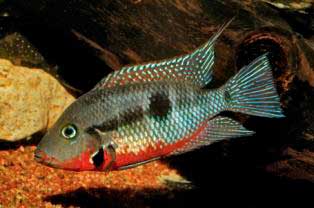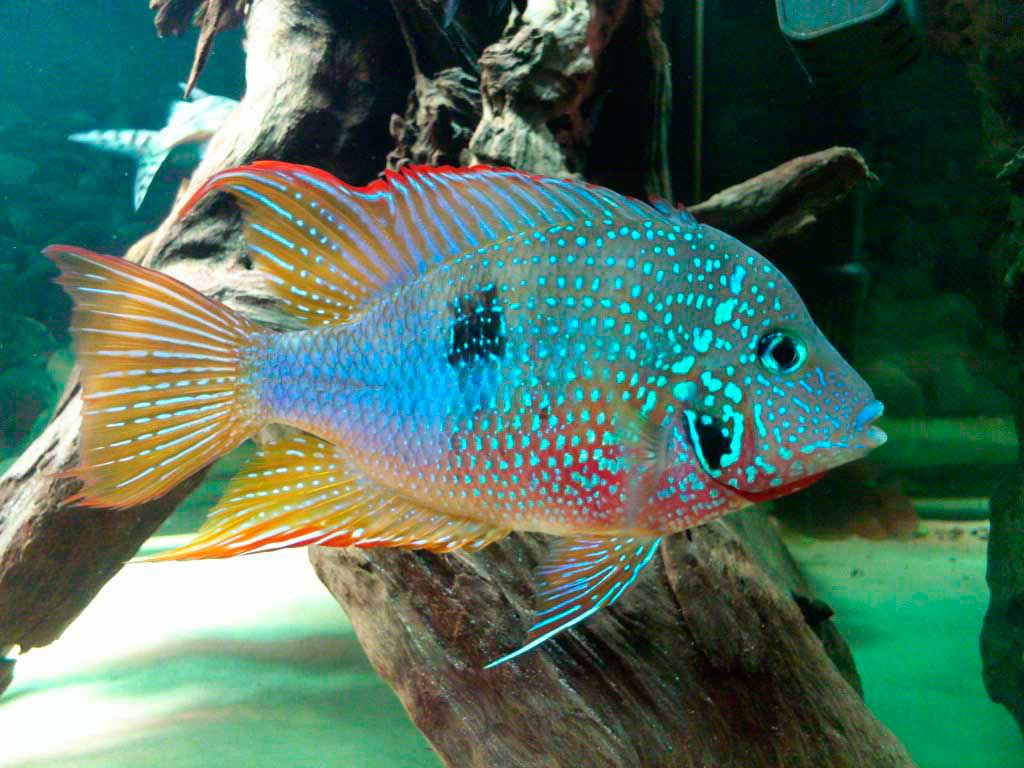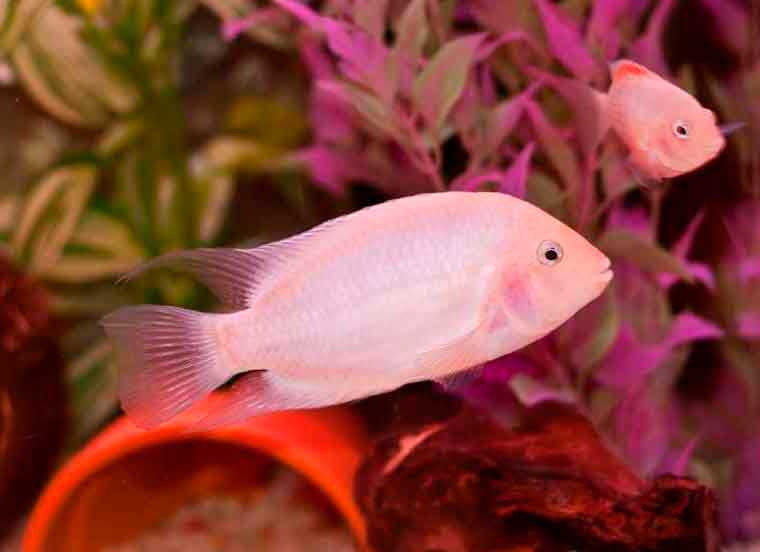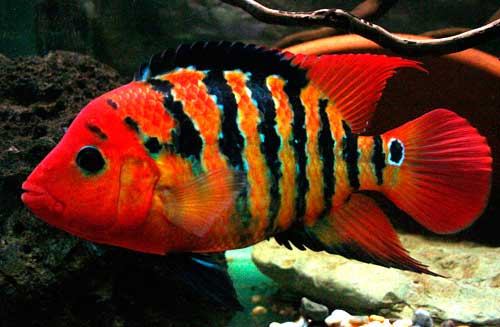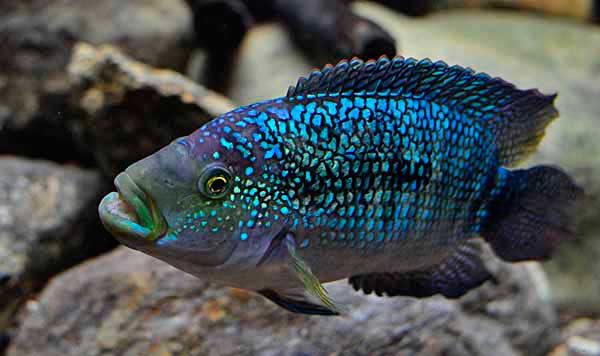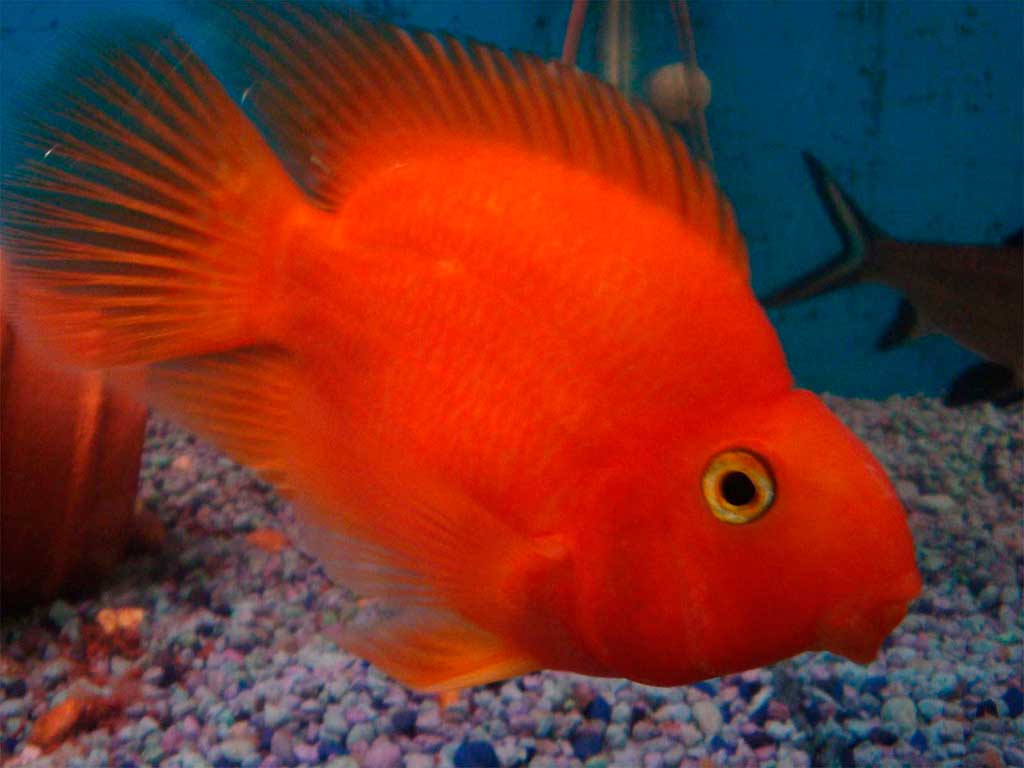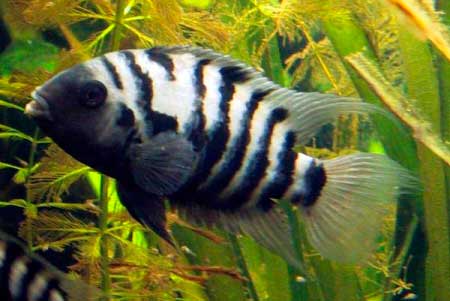The Cichlasoma meeka is one of the most beautiful American cichlids. It was first described at the dawn of the last century, namely in 1918 by the American researcher Walter L. Brind. The fish was named in honor of the American ichthyologist Seth Eugene Meek. After revision of the genus Cichlasoma this species was assigned to the genus Thorichthys, so now it would be more correct to call the article about this fish Thorichthys meeki.
But given that until now, the old name is more widespread in spite of the classifiers, we will leave the article about this fish more familiar name. Just take note that these two names refer to the same species. Fish from this has not become less attractive, and the conditions of its content have not changed. In Europe, Cichlasoma Meeka first got to Europe by 1933, where it was brought from the island of Yucatan. In the Soviet Union Cichlasoma meeki got thanks to the efforts of the People’s Artist of the USSR Sergey Vladimirovich Obraztsov, who was not only a talented puppeteer, but also an avid aquarist.
| kingdom | Animals |
| type | Chordates |
| class | Radial fish |
| division | Perch |
| Family | Cichlids |
| genus | Thorichthys |
| species | Cichlasoma meeka |
Synonyms: Thorichthys meeki, masked, red throated, Firemouth Cichlid (англ.), Feuermaulbuntbarsch (German.), С. hyorhynchum, Amphilophus meeki, Nandopsis meeki.
Habitat.: In the nature inhabits the water bodies of the Yucatan Peninsula, as well as on the territory of Mexico, Guatemala, as well as Belize.
Cichlasoma meeka Description
It has a slightly elongated tall body about twelve centimeters long. The back line is more curved than in other representatives of the genus. The head is somewhat elongated. The mouth is relatively small. Dorsal and anal fins stretch from about the middle of the body to the base of the caudal fin, which has a lyre-shaped shape. The paired fins are transparent and, like the rest of the body, are studded with turquoise shiny spots. Unpaired fins have red edging.
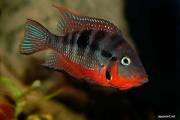
Iris eyes are also turquoise shiny. The abdomen, as well as the bottom of the gill covers are colored all shades of red, due to which this cichlasoma has received one of its common names – red throat. On the gill covers there are black dots imitating the pupils of the eyes. When there is danger, the fish extends its gills, so that its full-face appears to the aggressor monster of monstrous proportions. When the danger passes the gills take their normal position. For this ability to “dress” mask monster cichlasoma received another of its common name – masked. Fish territorial. Males like to occupy some secluded place on the bottom, and then jealously guard it and the area around it with a radius of about ten centimeters. Fry and females show a tendency to gregarious living.
Sex differences
The Meek’s cichlasoma is a monogamous creature. Pairs are formed from early childhood, and then remain for a long time. Individuals who have reached the age of eight to twelve months become sexually mature. The male has a larger size than the female. Moreover, they can be distinguished by size, starting from two months of age. Females are more modestly colored than their cavaliers. In males dorsal and anal fins are pointed at the ends, in females they are rounded. During spawning in the fish becomes brighter coloration, appear anal tubercles. In the male, this tubercle (seminal duct) is represented by a pointed cone, which can reach a length of 2 millimeters in the female this tubercle (ovipositor) is twice as large and has the appearance of a truncated cone.
Keeping Cichlasoma meeka in the aquarium
Keeping is simple and complex at the same time. Simplicity is due to the fact that adults are quite hardy. In compliance with simple rules of their content will not bring you disappointment. Complexity is determined by the constant implementation of these very simple rules, as well as the need for a fairly large dwelling for these fish. It is better to read yourself what is necessary for this species, and then decide for yourself whether it is difficult for you or not.
Aquarium volume
The minimum volume of the aquarium, which is suitable for a pair of these fish, should be at least fifty liters. Although being a child, I kept a couple in a volume of twenty-five liters, in addition, they even managed to spawn there. But this is more of a casuistry than a rule. Or I was just lucky then, or the lack of space was compensated by a child’s passion and tireless care for such a modest dwelling. Now I do not recommend anyone to experiment in this way. And for two – three pairs requires a volume of 150-200 liters. Not every modern apartment has room for an aquarium of this volume. The aquarium must necessarily be equipped with a lid or covered with at least ordinary glass, so that these paranoids do not jump out on every occasion and without any reason.
Soil
Cichlasoma Meeka likes to dig up the soil, dig up plants, stirring up the water. Therefore, it is better to cover the bottom with small pebbles or granite chips, and plant plants in pots.
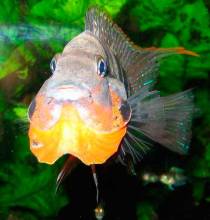
If the plants are supposed to be planted in the ground, then as a substrate standard use gray river sand. And it will have to be poured in a layer of at least 8 centimeters. At the bottom you should arrange a few grottoes of large stones or put at the bottom of a few unused pottery pots.
Plants and Meek’s Cichlasoma.
A layer of 8 centimeters of soil is needed because plants for the aquarium will need to be selected with a strong rhizome and tough leaves. You can use cryptocoryne, echinodorus, valisneria, elodea are also suitable.
Environmental parameters
The temperature for maintenance should be between 22 and 24 degrees Celsius. The hardness is up to 20°dH. Active water reaction pH – 6.5 – 7.5.
Lighting
There are no specific lighting requirements. But they look more spectacular under bright lighting. As a rule, 0.5 W/l total power of fluorescent lamps is sufficient.
Aeration, Filtration
External or internal filters are required to filter out the turbidity. Additional artificial aeration should also be established and work around the clock. Cichlasoma Meeka likes clean water saturated with oxygen. Poorly tolerates high levels of nitrates and almost does not tolerate nitrites. Biological filter if there is an opportunity to install it, will make it easier for you to care for the home of these “princesses on the pea”. If not, it is necessary not to forget weekly, replace 30% of the water with fresh and temperate.
Cichlasoma meeka Compatibility
Cichlasoma meeka is the most peaceful species of its genus. Oh yes, but everything is known in comparison!!! You can not keep next to them small, slow and voile fish they will be unceremoniously mixed up with food … In extreme cases with them you can keep a flock of swift barbs. But still think carefully before putting them there.
Nutrition
God has not deprived them of an appetite. They will eat everything that you offer them moths, trumpet fish, earthworms, insect larvae and insects themselves. It is obligatory to give vegetable food – scalded with boiling water, crushed leaves of lettuce, dandelion, dried nettle.
Cichlasoma meeka Breeding
It is better to breed in the same aquarium in which they are kept. Transfer to the spawning tank can cause them stress, which will discourage them from breeding. Stimulate spawning can be increased water temperature to 26 – 28 degrees Celsius, as well as reducing carbonate hardness to 2 degrees. Such hardness can be achieved by boiling water for 10 – 15 minutes.
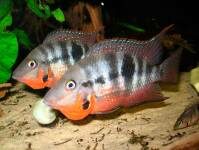
When the male realizes that nature is favoring him, he will clean one of the flat stones that you have thoughtfully placed on the bottom. He will then invite the female to join him. She will lay on this stone from 100 to 300 eggs. The spouses take care of the eggs together.
The incubation period lasts 3-4 days. After another three days, the fry will swim. From this point they can be fed nauplii Artemia, and then small crustaceans. You can also feed young artificial feed koi now more than enough. After the fry swim should either drain them into a growing aquarium with a wide hose, or put away their parents.
As the fry grow, they should be sorted by size to avoid cannibalism.
Additional information:
In close inbreeding Cichlasoma meeki prone to degeneration, which occurred in the Soviet Union, but in 90 years to our aquarists got a new batch of these wonderful fish caught from natural reservoirs. It is not recommended to coexist with C. nigrofasciatum, C. aureum, C. spilurum, as with these species can be formed hybrids.
Cichlosoma meeka is an amazing, very beautiful fish. All those “difficulties” that are described above can well be called just features. But acquiring these wonderful fish and creating for them normal conditions of existence, you will get a lot of pleasure, which will bring you the observation of these graceful creatures. By the way, Cichlasoma Meeka one of the few fish are able to recognize and even love their owner. True for this and he must love them.
